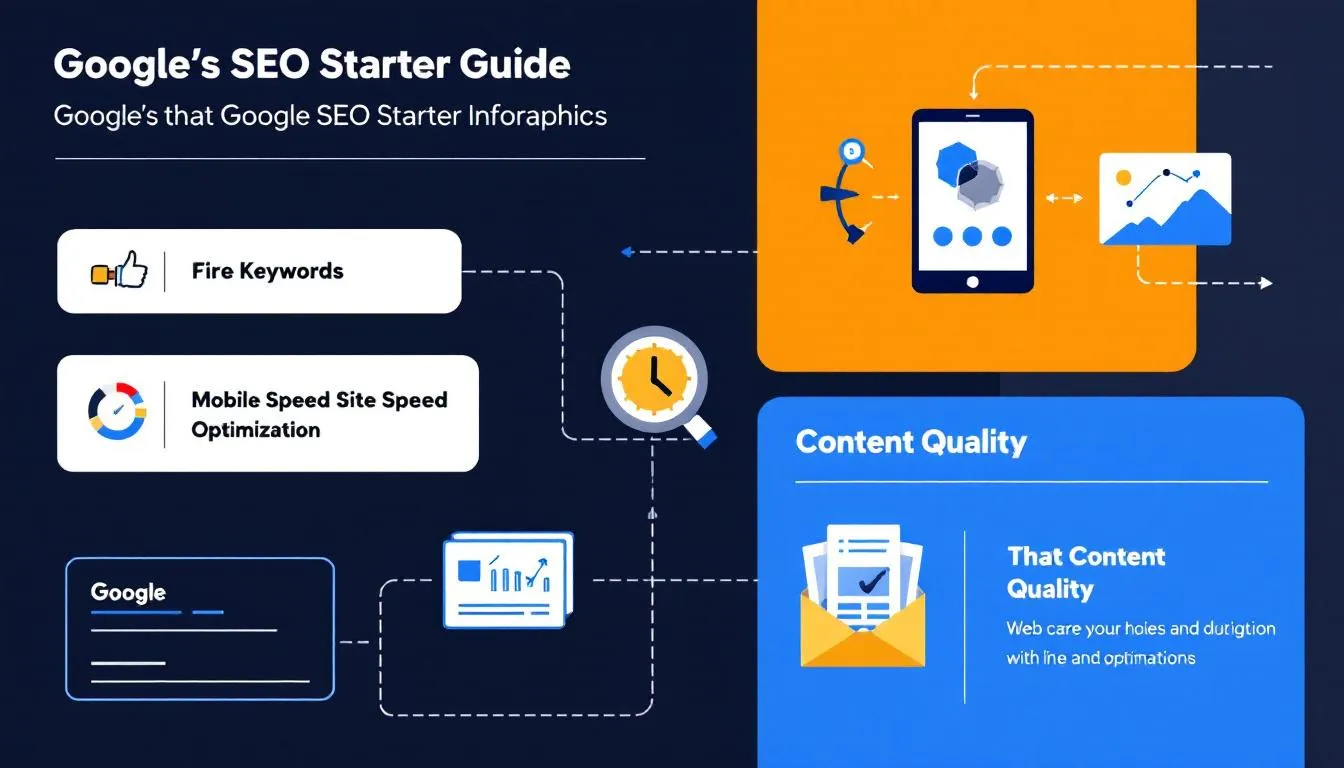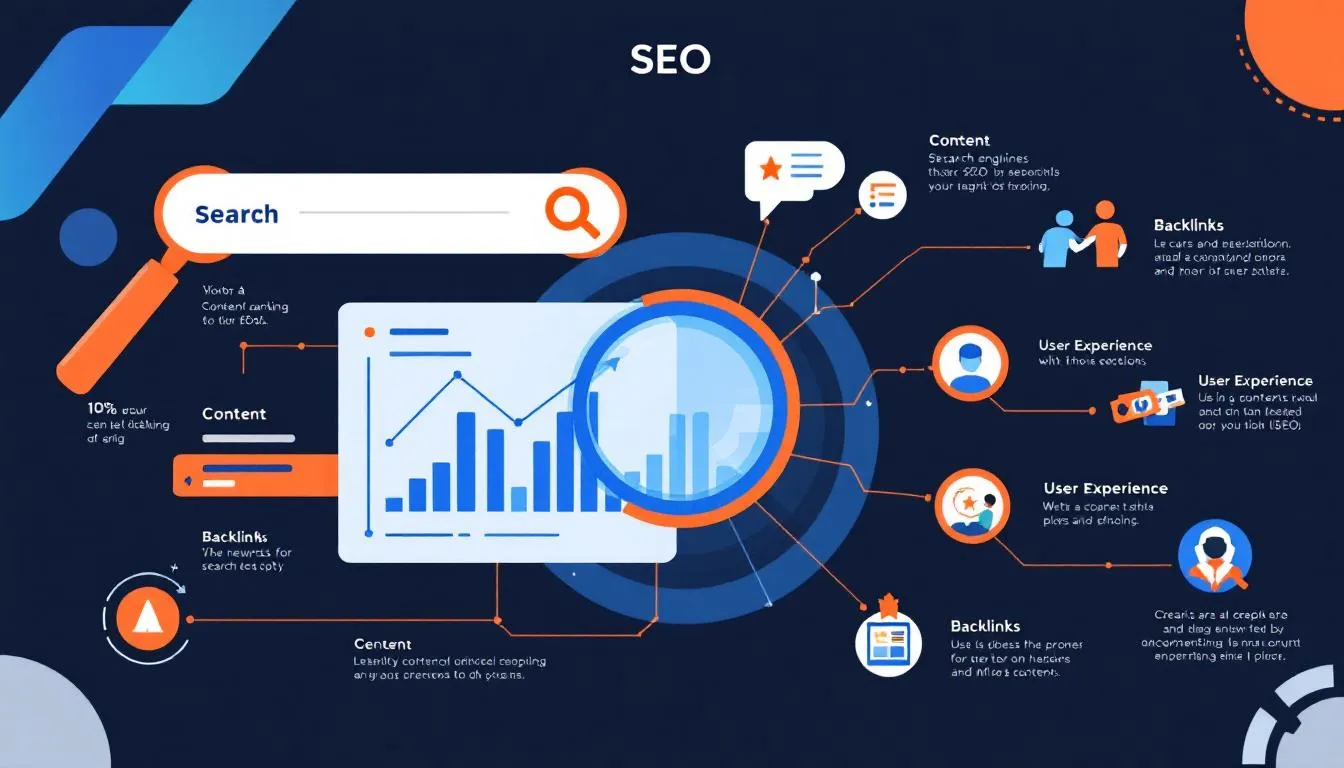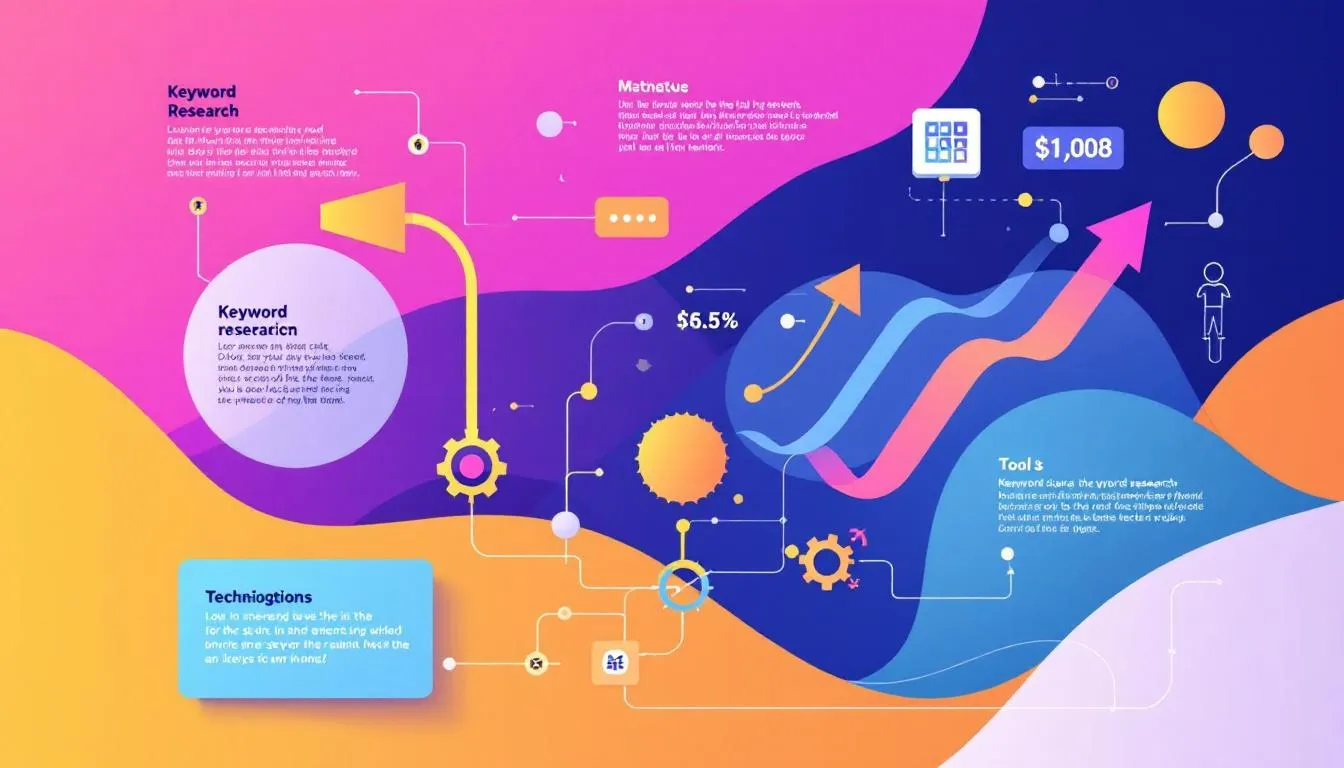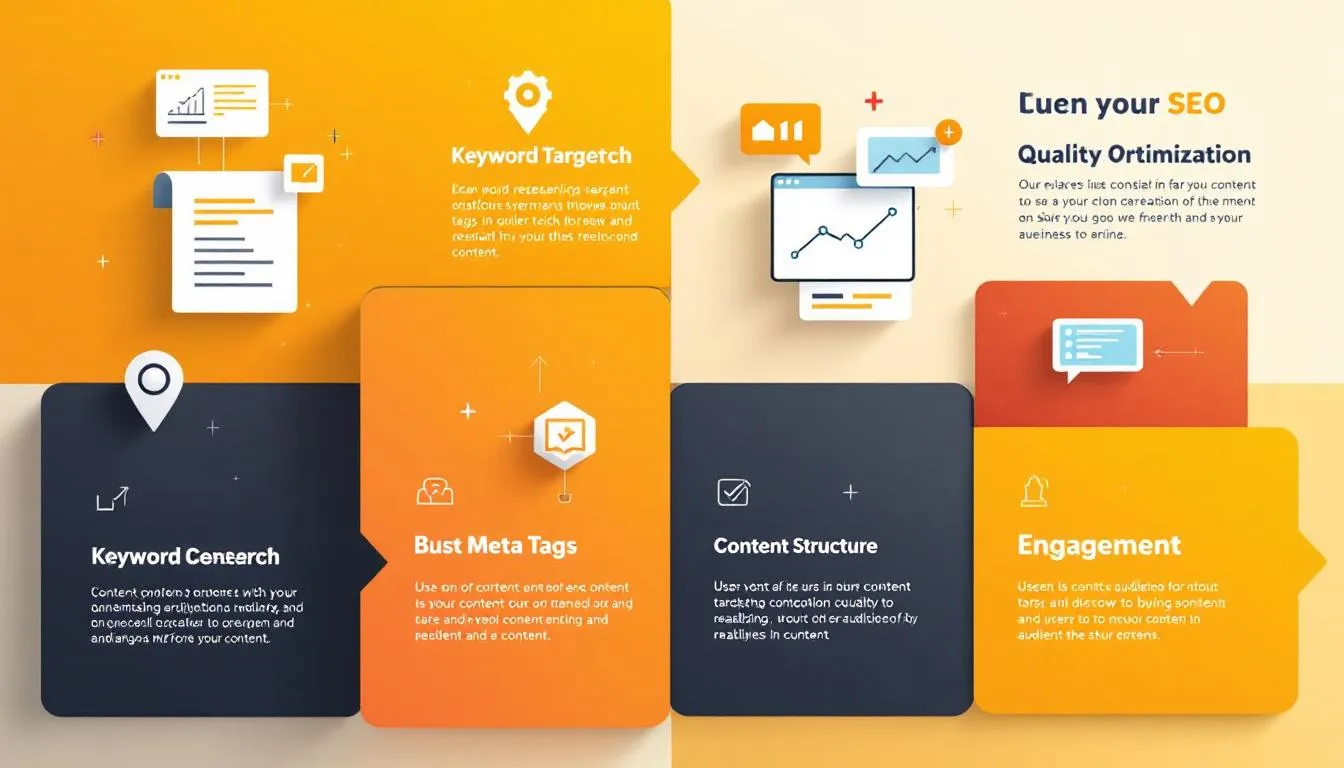Key Takeaways
- Understanding core SEO components such as on-page, technical, and off-page strategies is vital for improving website visibility and performance.
- Crafting high-quality content that aligns with user intent and effectively utilizing meta descriptions are crucial for enhancing search rankings.
- Regular monitoring and analysis of SEO performance through tools like Google Analytics and conducting SEO audits help maintain and enhance a site’s search engine effectiveness.
Understanding Google’s SEO Starter Guide

Google’s SEO Starter Guide is your roadmap to understanding how to make your website more accessible and relevant to search engines. This guide aims to provide marketers with a foundational understanding of SEO strategies, covering all major aspects of SEO to help you achieve your online business goals. Enhancing your website’s positions in organic search results boosts its visibility and traffic, ultimately increasing brand awareness and attracting potential customers.
The SEO Starter Guide emphasizes the essentials of SEO, the importance of creating helpful content, and delivering exceptional user experiences. Learning the basics of SEO is a vital first step for any business looking to thrive online. Additionally, optimizing for Google generally works well for other search engines too, making it a versatile endeavor.
At the core of the guide is the concept of SEO as a continuous process involving various methods, including advertising and improving organic search positions. Compelling content is crucial for improving search visibility and user engagement, reinforcing the importance of quality content in your SEO efforts. This guide serves as your foundation for a successful SEO journey.
Key Components of SEO

SEO is the art and science of enhancing a website’s visibility in organic search results. It involves a combination of various components that work together to improve your website’s performance and rankings. Understanding these components is crucial for developing an effective search engine optimization seo strategy that can help you achieve higher rankings and drive more traffic to your site.
The key components of SEO can be broadly categorized into:
- On-page SEO: Focuses on optimizing individual web pages to rank higher and earn more relevant traffic.
- Technical SEO: Ensures that your website is accessible and crawlable by search engine bots, which is fundamental for achieving good rankings.
- Off-page SEO: Involves activities that enhance your website’s authority and reputation through external efforts like link building and social media engagement.
Each of these components plays a distinct yet interconnected role in the overall SEO strategy.
We will delve into each of these components in detail, exploring on-page SEO essentials, technical SEO basics, and off-page SEO fundamentals to provide a comprehensive understanding of a successful SEO strategy.
On-Page SEO Essentials
On-page SEO is the cornerstone of search engine optimization, focusing on optimizing individual web pages to rank higher and attract more relevant traffic. It involves several key elements that work together to enhance your website’s visibility in search engine results. Title tags, for instance, are essential as they summarize the content of a page and should ideally include the focus keyword near the beginning. Meta descriptions provide a brief summary of a web page’s content and are crucial for encouraging user clicks from search results.
Using focus keywords naturally within the content is vital for on-page SEO. Key strategies include:
- Incorporating focus keywords into H1 tags and throughout the page to enhance optimization without keyword stuffing.
- Adding alt text for images to help search engines understand the content and context of images, boosting SEO.
- Creating descriptive URLs that are readable and concise, contributing to better user experience and SEO ranking.
Optimizing these elements collectively improves a page’s search engine ranking. H1 tags define the main subject of a page and are important for both user experience and SEO. Focusing on these on-page SEO essentials, including the title tag, can significantly enhance your website’s performance in search results, making your content more accessible and engaging for users.
Technical SEO Basics
Technical SEO is the backbone of search engine optimization, ensuring that your website is accessible, secure, and performs well in search engine rankings. Key aspects include:
- Crawlability: the ability of search engine bots to access and navigate your website, which is crucial for indexing and ranking.
- Google discovers pages mainly by following links from other pages that have already been crawled, improving the overall crawlability of the web.
- Proper content organization within directories affects how Google crawls and indexes your site.
Indexability is another critical aspect of technical SEO. It refers to the ability of a web page to be stored in a search engine’s index, which directly affects its visibility in search results. Creating and submitting an XML sitemap helps improve indexation by guiding search engines to your pages.
HTTPS, the secure version of HTTP, encrypts data between the user’s browser and the website, influencing search engine rankings. Implementing HTTPS is essential for proper SEO and securing your website visitors.
Using tools like Yoast SEO and other seo tools can help in the following ways:
- Creating sitemaps
- Conducting site audits to identify and rectify technical issues
- Improving site speed
- Enhancing security
- Increasing accessibility
These are critical elements of technical SEO that impact overall performance. Focusing on these technical SEO basics ensures that your website is well-optimized for search engine crawlers and provides a smooth user experience.
Off-Page SEO Fundamentals
Off-page SEO involves activities that enhance your website’s authority and reputation, primarily through acquiring quality backlinks. Backlinks are critical in determining a site’s authority and relevance, as search engines treat them as endorsements of content quality. Earning links and mentions from reputable websites contributes significantly to a site’s authority and search visibility.
Adhering to white hat SEO techniques, which emphasize user-oriented approaches and quality content, is vital for effective off-page SEO. These techniques help in acquiring quality backlinks ethically, enhancing your website’s credibility and rankings. The surrounding text of a link also carries contextual information relevant to the linked content, making it an important factor in SEO.
Focusing on off-page SEO fundamentals helps build a robust link profile that boosts your website’s authority and improves its performance in search engine rankings. This holistic approach to SEO ensures that your website not only ranks higher but also maintains its position through ethical and sustainable practices.
Effective Keyword Research Strategies

Keyword research is the cornerstone of any successful SEO strategy. It involves identifying and analyzing the terms people search to find keywords and information online, including on search engines and social media. Keywords are the words or phrases that users type into search engines, and understanding these target keyword search terms is crucial for enhancing your site’s performance in search results.
Effective keyword research involves more than just finding high-volume keywords; it requires identifying relevant and promising keywords that align with user intent. The focus has shifted from merely targeting high search volumes to finding keywords that fulfill user intent and drive conversions. Evaluating keyword difficulty helps determine how challenging it will be to rank in the top search results for a keyword, while monthly search volume indicates the potential traffic a keyword can bring.
We’ll explore how to use Google Search Console for keyword analysis and the benefits of free and paid keyword research tools. These tools and strategies help uncover the right keywords to target, ensuring your content meets user needs and ranks well in search results.
Using Google Search Console for Keywords
Google Search Console is a powerful tool for analyzing keyword performance and understanding user behavior. The Performance Report in Google Search Console allows users to:
- Analyze keyword performance, including clicks and impressions
- Gain valuable insights into how users interact with your website
- Identify which queries lead to impressions and clicks, which you can also google find.
This data helps you refine your SEO strategy accordingly.
Using the Intent filter in Google Search Console can help identify keywords with high search intent, which are crucial for driving conversions. Leveraging insights from the Performance Report and Intent filter can significantly enhance your site’s SEO performance, ensuring that your content aligns with user intent and meets their needs.
Regularly monitoring and analyzing keyword data in Google Search Console allows you to make informed decisions that improve your website’s visibility and drive more organic traffic. This proactive approach to keyword research ensures that your SEO efforts are always aligned with user behavior and search engine algorithms.
Free and Paid Keyword Research Tools
Keyword research tools are essential for discovering relevant keywords and gaining insights into their performance. A keyword research tool typically offers limited features compared to paid options, impacting the depth of analysis that can be conducted. However, they can still provide valuable data for identifying keywords and understanding search trends.
Paid tools like Semrush’s Keyword Magic Tool offer advanced features for discovering related keywords from a seed keyword and evaluating keyword rankings. These tools provide essential metrics such as monthly search volume, competition level, and keyword difficulty, which are crucial for developing an effective keyword strategy. Incorporating a mix of head terms and long-tail keywords within your keyword strategy balances high search potential with lower competition.
Utilizing both free and paid keyword research tools helps uncover a wide range of more keyword ideas and develop a comprehensive keyword strategy. This approach ensures that you target the right keywords to drive traffic and improve your website’s performance in search results.
Optimizing Content for SEO

Optimizing content for SEO is essential for enhancing your website’s performance in search results. High-quality, unique, and helpful content significantly boosts search engine visibility. It’s not just about stuffing keywords; it’s about creating content that aligns with user intent and provides real value. Understanding what users are truly looking for and matching that with your content is crucial for ranking well.
To achieve high rankings, authors must demonstrate expertise, authoritativeness, and trustworthiness in their content. Incorporating relevant keywords naturally within the content improves the chances of appearing in search results for those keywords. Compelling and useful content not only attracts more visitors but also keeps them engaged, influencing your website’s presence in search results.
We’ll explore how to craft high-quality content and effectively utilize meta descriptions. These techniques help create content that resonates with your audience and ranks well in search engines.
Crafting High-Quality Content
Creating high-quality content is the cornerstone of successful SEO. Content that demonstrates expertise and authority is more likely to rank higher in search results. Engaging content often leads to higher user retention and satisfaction, which are critical factors for SEO success. Unique and high-quality content also attracts backlinks from influencers and industry leaders, further boosting your site’s authority and rankings.
Guest posting is an effective method for generating backlinks while establishing credibility in your industry. By consistently producing valuable content, including a blog post, and sharing it through various channels, you can build a strong online presence and improve your website’s search engine performance.
Remember, quality over quantity is key when it comes to content creation.
Utilizing Meta Descriptions Effectively
Meta descriptions play a vital role in influencing click-through rates from search results. Compelling meta descriptions can significantly enhance the chances of users clicking through to your site. An engaging and well-written meta description directly impacts a webpage’s click-through rate, making it an essential element of on-page SEO.
To write effective meta descriptions, ensure they are concise and accurately reflect the content of the page. Combining clarity with a compelling call-to-action encourages users to click on your link.
Optimizing your meta descriptions improves your site’s visibility and attracts more visitors from search engine results.
Enhancing User Experience

User experience (UX) is integral to SEO success as it directly influences site engagement and rankings. A better experience for visitors leads to higher rankings, making UX a key focus for today’s SEO strategies. Important elements contributing to user experience include:
- Site speed
- Ease of navigation
- Mobile-friendliness
- High-quality content.
Quality content should be pleasant to consume and of high caliber to ensure a good user experience. Clear navigational elements help facilitate easy navigation for users, while avoiding distracting advertisements maintains user attention. Technical SEO ensures that a website is accessible and provides a smooth user experience, which is crucial for maintaining high engagement levels.
We’ll explore how to enhance mobile friendliness and optimize page speed. These aspects are critical for providing a seamless user experience and improving your site’s performance in search results.
Mobile Friendliness
A mobile-optimized site is essential to comply with Google’s mobile-first indexing approach. As of 2019, Google utilizes a mobile-first indexing method, which prioritizes the mobile version of a site for indexing and ranking. This means that if your site isn’t mobile-friendly, it could significantly impact your rankings and overall SEO performance.
To ensure your site is mobile-friendly, focus on responsive design, easy navigation, and fast load times on mobile devices. Optimizing your site for mobile users and their user’s browser provides a better user experience, leading to higher engagement and improved search engine rankings.
Page Speed Optimization
Page speed is a critical factor in user experience and search engine rankings. Faster page speed improves user experience, leading to higher engagement and lower bounce rates. Image compression removes unnecessary image data while maintaining quality, which can significantly reduce load times. The ideal image formats recommended for better quality and reduced file size include WebP, JPEG 2000, and JPEG XR.
Lazy loading prioritizes visible content loading first while deferring the rest, which is useful for image-heavy pages. Caching improves page loading speed by storing copies of files to avoid redundant requests, with the main types being server caching and browser caching. Utilizing tools to measure page speed can help identify areas for improvement in load times.
Focusing on these page speed optimization techniques ensures that your website provides a fast and seamless experience for users, leading to improved engagement and higher search engine rankings.
Building a Strong Link Profile
A strong link profile is essential for SEO, as backlinks are critical in determining a site’s authority and relevance. Backlinks demonstrate to search engines that other websites find your content valuable, which can significantly impact your search rankings. The quality and quantity of backlinks directly correlate with a website’s search rankings, making link building a crucial aspect of SEO.
Having a diverse backlink profile, with links from multiple referring domains, significantly enhances a website’s Domain Authority. Ethically acquiring backlinks involves providing valuable content that others want to link to, adhering to white hat SEO techniques. Popular metrics to estimate a page’s authority include Domain Authority and Page Authority by Moz.
We’ll explore internal linking strategies and techniques for acquiring quality backlinks. These strategies help build a robust link profile that enhances your website’s authority and search engine performance.
Internal Linking Strategies
Internal links enhance a site’s crawlability by establishing a clear navigation path for search engines. Key points about using descriptive anchor text include:
- It helps search engines and users understand the context of the linked pages.
- It improves rankings within search engines.
- Using descriptive text in blogs is important instead of generic terms like ‘Read more’ to provide clarity and context.
The golden rule of effective internal linking states that any page should be no more than three clicks from the homepage. This ensures easy navigation throughout the site. Including contextual in-text links and ‘further reading’ boxes can enhance website content relevance and improve user engagement. Implementing effective internal linking strategies improves your site’s crawlability and search engine rankings.
Acquiring Quality Backlinks
Creating unique and valuable content can encourage influencers to link to it or share it on social media. Promoting a linkable asset involves contacting websites that might be interested in linking to you or influencers for feedback. Guest posting is a sought-after link-building technique where authors write for other sites, gaining valuable backlinks.
Email outreach can be an effective way to gain backlinks through competitor analysis using strategies like the Skyscraper Technique. When evaluating backlinks, consider factors like the domain rating, organic traffic, and growth in referring domains to assess quality. Backlinks from high-authority sites are crucial for improving a web page’s ranking on search engine results pages.
A successful link-building strategy should include various methods to acquire links for a diverse backlink profile. Researching competitor backlinks can help define effective strategies for your link-building campaign. Focusing on acquiring quality backlinks improves your site’s authority and search engine performance.
Monitoring and Analyzing SEO Performance
Monitoring and analyzing SEO performance is crucial for understanding your website’s visibility and effectiveness in search results. Comprehensive monitoring includes analyzing keyword rankings, website performance, and authority. Competitor analysis is also part of SEO monitoring, allowing you to adapt strategies to outperform others.
Website analytics is essential for tracking and analyzing performance, with tools like Google Search Console providing performance reports and identifying critical issues. Most analytical tools can set up email alerts for dramatic changes in performance, ensuring you stay informed about your site’s status. When interpreting rank tracking data, consider data realistically, as improvements may not immediately yield traffic.
We’ll explore how to use Google Analytics for insights and the importance of regular SEO audits. These practices help maintain and improve your site’s SEO performance continuously.
Google Analytics Insights
Google Analytics is a free tool for tracking website traffic and user behavior, providing valuable insights into your site’s performance. It measures traffic, user behavior, and conversion rates, helping you understand how users interact with your site. Audience-centric metrics, including new users and session counts, offer a comprehensive view of user engagement.
The reports and features mentioned include:
- The All Pages report, which helps determine user interests and page improvement needs based on traffic patterns.
- Annotations in Google Analytics, which can be used to add context to analytics dashboards by highlighting specific events affecting performance.
- The Landing Pages report, which shows the top new pages visitors use to enter the website, providing insights into which relevant pages drive traffic, including all your pages.
Leveraging Google Analytics insights allows you to make data-driven decisions to enhance your site’s performance and user experience. Regularly analyzing these metrics ensures that your SEO efforts are aligned with user behavior and search engine algorithms.
Regular SEO Audits
Regular SEO audits are essential for identifying and rectifying issues affecting search rankings. Using tools like Semrush’s Site Audit can streamline the SEO auditing process, making it easier to spot and fix problems. SEO is a continuous effort, requiring regular evaluations to maintain and improve performance.
Analyzing various dimensions is crucial when addressing declines in SEO performance. Conducting regular SEO audits ensures that your site remains optimized and competitive in search engine rankings. This proactive approach helps you stay ahead of potential issues and maintain a strong online presence.
Keeping Up with SEO Trends
SEO is evolving all the time, and keeping up with the latest trends is crucial for maintaining a competitive edge. While it may take a few weeks to learn the basics, mastering SEO can take months or even years. AI is increasingly utilized to enhance content creation, allowing writers to focus on quality and unique insights.
The rise of zero-click searches, driven by AI summaries in Google’s search results, is expected to impact click-through rates negatively. This trend underscores the importance of optimizing content for featured snippets and other SERP features. Staying updated with SEO trends ensures that your strategies remain effective and your website continues to rank well in search results, a crucial ranking factor. Understanding how search engines work is essential for adapting to these changes.
Continuous learning and adaptation are key to SEO success. Staying informed about emerging trends and incorporating new techniques into your SEO strategy ensures that your site remains relevant and competitive in the ever-changing digital landscape.
Summary
Mastering SEO in 2025 requires a comprehensive understanding of Google’s SEO Starter Guide and its key components. From on-page essentials to technical intricacies, and from keyword research to content optimization, each aspect plays a crucial role in enhancing your website’s visibility and performance. By focusing on user experience, building a strong link profile, and continuously monitoring your SEO performance, you can achieve higher rankings and drive more traffic to your site.
As we move forward, staying updated with SEO trends and continuously adapting your strategies will be essential for maintaining a competitive edge. Remember, SEO is a continuous journey that requires dedication, learning, and adaptation. Embrace the journey, and your efforts will be rewarded with a thriving online presence.
Frequently Asked Questions
What is the primary goal of Google’s SEO Starter Guide?
The primary goal of Google’s SEO Starter Guide is to assist users in improving their site’s accessibility and relevance for search engines, ultimately enhancing visibility and traffic. By following its guidelines, you can effectively optimize your website for better search performance.
Why is keyword research crucial for SEO?
Keyword research is essential for SEO as it helps identify relevant keywords that match user intent, driving targeted traffic and enhancing a website’s visibility in search results. Prioritizing effective keyword strategies is key to improving overall performance.
How does mobile-friendliness impact SEO?
Mobile-friendliness is crucial for SEO since Google prioritizes mobile versions of websites for indexing and ranking. A site that is not mobile-friendly may suffer in search engine performance and visibility.
What are some effective techniques for acquiring quality backlinks?
Creating unique and valuable content, promoting linkable assets, guest posting, and leveraging email outreach and competitor analysis techniques, such as the Skyscraper Technique, are effective methods for acquiring quality backlinks. Implementing these strategies can significantly enhance your link-building efforts.
Why are regular SEO audits important?
Regular SEO audits are crucial for maintaining and improving your site’s search rankings by identifying and fixing issues that could hinder optimization. They ensure your website remains competitive in an ever-changing digital landscape.
#GoogleSEO #SEOStarterGuide #OnPageSEO #TechnicalSEO #OffPageSEO #KeywordResearch #GoogleSearchConsole #ContentOptimization #MetaDescriptions #UserExperience #MobileSEO #PageSpeed #LinkBuilding #InternalLinking #Backlinks #GoogleAnalytics #SEOAudits #SEOTips #SEOTrends #SEO2025 #SEOChecklist #SEOForBeginners #SearchEngineOptimization #WhiteHatSEO #RankingFactors
